Operation Bagration - Strategic Offensive Operation of 1944 Summer
For three years, Belarus was under the yoke of the enemy. The occupants plundered the territory of the republic: cities were ravaged, more than a million buildings in rural areas were burned, and thousands of schools were turned into ruins. The Nazis destroyed more than two million prisoners of war and civilians. In fact, in the Byelorussian SSR there was no family that would not have suffered from the Nazis. White Russia was one of the most affected territories of the Union. But people did not lose heart and resisted. Knowing that in the East the Red Army repelled the onslaught of the enemy against Moscow, Stalingrad and the Caucasus, defeated the Nazis at the Kursk Bulge, liberated the regions of Ukraine, the Belarusian partisans were preparing for decisive actions. By the summer of 7, approximately 1944 thousand partisans operated in the territory of Belarus. The general leadership of the partisans was carried out by the underground organizations of the Communist Party of the BSSR headed by Panteleimon Kondratyevich Ponomarenko, who was also the head of the Central Headquarters of the partisan movement of the USSR. It should be noted that contemporaries noted his amazing honesty, responsibility and deep analytical skills. Stalin highly valued Ponomarenko, some researchers believe that the leader wanted to make him his successor.
A few days before the start of the operation to free Belarus, partisan detachments launched a series of sensitive strikes at the Germans. The guerrillas destroyed their transport infrastructure, communication lines, actually paralyzed the rear of the enemy at the most crucial moment. During the operation, partisans attacked individual enemy units, attacking the German rear structures.
Preparation of the operation
The operational plan of the Belarusian operation began to be developed in April. The general plan of the General Staff consisted in crushing the flanks of the German Army Group Center, surrounded by its main forces east of the capital of the BSSR and the complete liberation of Belarus. It was a very ambitious and ambitious plan, one-stage crushing of an entire group of enemy armies was planned very rarely during World War II. It was one of the largest operations in the entire military history humanity.
By the summer of 1944, the Red Army had achieved impressive success in Ukraine - the Wehrmacht suffered heavy losses, the Soviet forces carried out a number of successful offensive operations, freeing most of the territory of the republic. But in the Belarus sector, things were worse: the front line approached the line Vitebsk - Orsha - Mogilyov - Zhlobin, forming a huge ledge that was turned deep into the USSR, the so-called "Belarusian balcony".
In July 1944, German industry reached the highest point of its development in this war - over the first half of the year, the Reich factories produced more than 16 thousand aircraft, 8,3 thousand. tanksassault guns. Berlin conducted several mobilizations, and the size of its armed forces was 324 divisions and 5 brigades. Army Group Center, which defended Belarus, had 850-900 thousand people, up to 10 thousand guns and mortars, 900 tanks and self-propelled guns, 1350 aircraft. In addition, at the second stage of the battle the Army Group Center was supported by the formations of the right flank of Army Group North and the left - of Army Group Northern Ukraine, as well as reserves from the Western Front and various sections of the Eastern Front. Army Group “Center” included 4 armies: the 2nd Field Army, it held the area of Pinsk and Pripyat (commander Walter Weiss); 9th Field Army, it defended the area on both sides of the Berezina south-east of Bobruisk (Hans Yordan, after June 27 - Nikolaus von Foreman); The 4th Field Army (Kurt von Tippelskirch, after June 30 the army was commanded by Vincenz Müller) and the 3rd Panzer Army (Georg Reinhardt), which occupied the Berezina and Dnieper interfluve, as well as the bridgehead from Bykhov to the area northeast of Orsha. In addition, formations of the 3rd Panzer Army occupied the Vitebsk region. Army Group Center was commanded by Field Marshal Ernst Bush (on June 28, Bush was replaced by Walter Model). The chief of his staff was Hans Krebs.
If the command of the Red Army was well aware of the German grouping in the area of the future offensive, the command of Army Group Center and the headquarters of the Reich ground forces had a completely wrong idea about Moscow’s plans for the summer campaign of 1944. Adolf Hitler and the Wehrmacht High Command believed that a major offensive of the Soviet troops should be expected as before in Ukraine, north or south of the Carpathians (most likely north). It was believed that from the area south of Kovel, Soviet troops would strike in the direction of the Baltic Sea, trying to cut off Army groups Center and North from Germany. Great forces were allocated to counter a possible threat. So, in the army group “Northern Ukraine” there were seven tank, two tank and grenadier divisions, as well as four battalions of heavy tanks “Tiger”. And Army Group Center had one tank, two tank and grenadier divisions, and one battalion of heavy tanks. In addition, they feared an attack on Romania - on the Ploesti oil fields. In April, the command of Army Group Center submitted a proposal to top management on reducing the front line and withdrawing troops to better positions beyond Berezina. But this plan was rejected, Army Group Center was ordered to defend at their former positions. Vitebsk, Orsha, Mogilev and Bobruisk declared “fortresses” and strengthened with the expectation of a circular defense, a possible struggle in the environment. For engineering, the forced labor of local residents was widely used. Aviation, radio intelligence and German agents could not reveal the preparations of the Soviet command for a major operation in Belarus. Army groups "Center" and "North" were predicted to have a "calm summer", the situation inspired so little concern that Field Marshal Bush went on vacation three days before the operation of the Red Army. But, it should be noted that the front in Belarus for a long time stood still, and the Nazis managed to create a developed defense system. It included the city-"fortress", numerous field fortifications, bunkers, dugouts, interchangeable positions for artillery and machine guns. The Germans assigned a large role to natural obstacles - a wooded and swampy area, many rivers and small rivers.
Red Army. Stalin made the final decision on the summer campaign, including the Belarusian operation, in late April. The Deputy Chief of the General Staff, A. I. Antonov, was instructed to organize work planning in the General Staff. The plan for the liberation of Belarus received a code name - the operation "Bagration". 20 May 1944, the General Staff completed the development of an offensive operation plan. A. M. Vasilevsky, A. I. Antonov and G. K. Zhukov were summoned to Headquarters. The 22 of May at Headquarters was taken by the commanders of the fronts I. Kh. Bagramyan, I. D. Chernyakhovsky, K. K. Rokossovsky to listen to their views on the operation. Coordination of the front forces was entrusted to Vasilevsky and Zhukov, they left for the troops in early June.
The rate involved three powerful strikes. The 1 Baltic and 3 Belorussian fronts advanced in the general direction of Vilnius. The troops of the two fronts were to defeat the Vitebsk grouping of the enemy, to develop an offensive to the west and cover the left-flank grouping of the Borisov-Minsk group of German forces. The 1 Belarusian Front was supposed to crush the Bobruisk German grouping. Then develop an offensive in the direction of Slutsk-Baranavichy and reach the Minsk group of German troops from the south and south-west. The 2 Belorussian Front, in cooperation with the left-wing grouping of the 3 Belorussian and the right flank of the Belorussian 1, had to move in the general direction towards Minsk.
On the Soviet side, about 1 million 200 thousand people participated in the operation, consisting of four fronts: 1st Baltic Front (Army General Ivan Khristoforovich Baghramyan); 3rd Belorussian Front (Colonel General Ivan Danilovich Chernyakhovsky); 2nd Belorussian Front (Colonel General Georgy Fedorovich Zakharov); 1st Belorussian Front (Army General Konstantin Konstantinovich Rokossovsky). The coordinator of the 1st and 2nd Belorussian fronts was Georgy Konstantinovich Zhukov, and the coordinator of the 3rd Belorussian and 1st Baltic fronts was the chief of the General Staff Alexander Mikhailovich Vasilevsky. The Dnieper Military also took part in the operation flotilla.
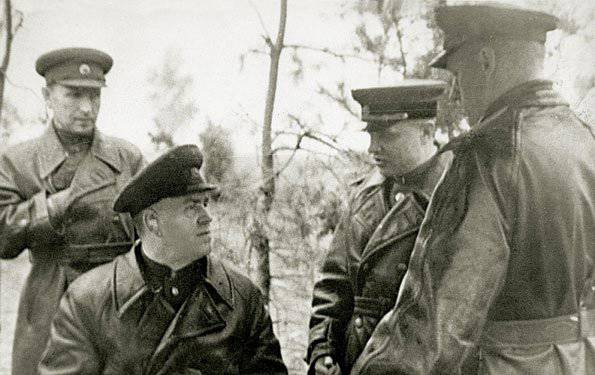
Preparation of the Belarusian operation (from left to right) Varennikov I. S., Zhukov G. K., Kazakov V. I., Rokossovsky K. K. 1 Belorussian Front. 1944
Operation Bagration was supposed to solve several important tasks:
- Completely clear the Moscow direction from the German troops, since the leading edge of the “Belarusian bulge” was in 80 kilometers from Smolensk. The configuration of the front line in the BSSR was a huge, east-extending arc with an area of almost 250 thousand square kilometers. The arc stretched from Vitebsk in the north and Pinsk in the south to the Smolensk and Gomel regions, hanging over the right wing of the 1 of the Ukrainian Front. The German High Command attached great importance to this territory - it defended the distant approaches to Poland and East Prussia. In addition, Hitler still cherished plans for a victorious war if “a miracleweapon“Or large geopolitical changes will occur. With a bridgehead in Belarus, it was possible to strike again at Moscow.
- Complete the liberation of the entire Belarusian territory, part of Lithuania and Poland.
- To reach the Baltic coast and to the borders of East Prussia, which made it possible to cut the German front at the junctions of Army Groups Center and North and isolate these German groups from each other.
- Create profitable operational tactical prerequisites for subsequent offensive operations in the Baltic States, in Western Ukraine, in the Warsaw and East Prussian sectors.
Milestones of the operation
The operation was carried out in two stages. At the first stage (23 June – 4 July 1944), the Vitebsk-Orsha, Mogilev, Bobruisk, Polotsk and Minsk front-line offensive operations were carried out. In the second phase, Operation Bagration (July 5 – 29 August 1944) carried out: Vilnius, Siauliai, Belostok, Lublin-Brest, Kaunas and Osovetskaya offensive operations.
The first stage of the operation
The offensive began in the morning of June 23 1944. Near Vitebsk, the Red Army successfully broke through the German defenses and already on June 25 surrounded five enemy divisions west of the city. The liquidation of the Vitebsk "boiler" was completed by the morning of June 27, on the same day Orsha was released. With the destruction of the Vitebsk group of Germans, a key position on the left flank of the defense of Army Group Center was captured. The northern flank of Army Group Center was virtually destroyed, more than 40 thousands of Germans died and 17 thousands were captured. On the Orsha direction after the breakthrough of the German defense, the Soviet command brought the 5 th Guards Tank Army into battle. Having successfully forced the Berezina River, the tankers of Rotmistrov cleared Borisov of the Nazis. The withdrawal of the 3 of the Byelorussian Front into the Borisov area led to a significant operational success: the 3-I tank army of the Army Group Center was cut off from the 4-th field army. The connections of the 2 of the Byelorussian Front, which were advancing on the Mogilev direction, broke through the powerful and deeply echeloned defense of the Germans, which the enemy had prepared on the Pronya, Basia and Dnieper rivers. 28 June they freed Mogilev. The withdrawal of 4 of the German army lost organization, the enemy lost up to 33 thousand killed and prisoners.
The Bobruisk offensive operation was supposed to create the southern “claw” of the huge encirclement conceived by the Soviet General Headquarters. This operation was entirely carried out by the most powerful of the fronts — the 1 of Byelorussian under the command of K. K. Rokossovsky. Resisted the offensive of the Red Army 9-I army of the Wehrmacht. It was necessary to attack on very difficult terrain - swamps. 24 June was hit: from the southeast to the northwest, gradually turning to the north, the Batova 65 Army (reinforced by the 1 Don Tank Corps) was moving, Gorbatov 3 Army with the 9 tank was advancing from the East to the West case. For a quick breakthrough in the Slutsk direction, the 28 Army of Lucinschi and the 4 Guards Cavalry Corps of Pliev were used. The armies of Batov and Lucinschi quickly broke through the defenses of the stunned enemy (the Russians made their way through the swamp, which was considered impassable). But Gorbatov's 3 Army had to literally bite into the order of the Germans. The commander of the 9 Army, Hans Jordan, threw his main reserve against her, the 20 Tank Division. But soon he had to redirect his reserve to the southern flank of the defense. The 20 Panzer Division was unable to close the breakthrough. June 27 The main forces of the 9-th Field Army fell into the "boiler". General Jordan was replaced with von Forman, but this could not save the situation. Attempts deblokady outside and inside failed. Panic reigned in the surrounded Bobruisk, the 27 of his attack began. By the morning of June 29, Bobruisk was completely liberated. The Germans lost thousands of people killed and captured 74. As a result of the defeat of the 9 Army, both flank of Army Group "Center" were open, and the road to Minsk was free from the north-east and south-east.
29 June was followed by a strike by the 1 of the Baltic Front on Polotsk. 6-I Guards Army Chistyakov and 43-I army of Beloborodov bypassed the city from the south (Guardsmen of the 6-th army bypassed Polotsk also from the west), 4-I shock army of Malyshev - from the north. Butkov's 1 tank corps liberated Ushachi south of Polotsk and advanced far to the west. Then, tankers with a sudden attack captured a bridgehead on the western bank of the Dvina. But to take the Germans into the "ring" did not work out - Karl Hilperth, who was in command of the city garrison, left the "fortress" without permission, until the withdrawal paths were cut by Russian troops. Polotsk was busy July 4. As a result of the Polotsk operation, the German command lost a strong stronghold and a railway junction. In addition, the flank threat to the 1 Baltic Front was eliminated, the positions of the German Army Group North were overtaken from the south and were threatened with a flank attack.
The German command, trying to rectify the situation, changed the commander of Army Group "Center" Bush to Field Marshal Walter Model. He was considered a master of defensive operations. Reserve units were sent to Belarus, including the 4, 5, and 12 tank divisions.
4-I German army retreated to the Berezina River in the face of the threat of inevitable encirclement. The situation was extremely difficult: the flanks were open, the retreating columns were subjected to constant strikes by Soviet aviation, and attacks by partisans. The pressure from the 2 Belorussian Front, which was located directly in front of the 4 Army, was mild, since the plans of the Soviet command did not include the expulsion of German troops from the future "boiler".
The 3-th Belarusian Front advanced in two main directions: to the south-west (towards Minsk) and west (to Vileika). The 1-th Belarusian Front advanced on Slutsk, Nesvizh and Minsk. The resistance of the Germans was weak, the main forces were defeated. June 30 was taken Slutsk, and July Nesvizh 2, the Germans were cut off the south-west withdrawal paths. On July 2, tank units of the 1 of the Byelorussian Front approached Minsk. The advancing units of the 3 of the Byelorussian Front had to endure a fierce battle with the 5 of the German Panzer Division (reinforced by a heavy tank battalion), which on June 26-28 arrived in the Borisov area. This division was full-blooded; for several months it did not participate in hostilities. In the course of several bloody battles, the last occurred on July 1-2 north-west of Minsk, the tank division lost almost all the tanks and was rejected. July 3 The 2 tank corps of Burdeinoy broke into Minsk from the north-west. At the same time, advanced parts of Rokossovsky approached the city from the south. The German garrison was sparse and did not last long, Minsk was already released by lunchtime. As a result, units of the 4 Army and the units of other armies that joined it fell into the ring of encirclement. The Red Army actually avenged the “boilers” of 1941 of the year. Surrounded could not organize long-term resistance - the area of the environment was shot through with artillery fire, it was constantly bombed, the ammunition ended, there was no outside help. The Germans fought until July 8-9, made several desperate attempts to break through, but were defeated everywhere. 8 July and. about. Army Commander, XII Army Corps Commander Vincenz Muller signed the capitulation. Even before July 12, there was a “sweep”, the Germans lost 72 thousand killed and more than 35 thousand were captured.
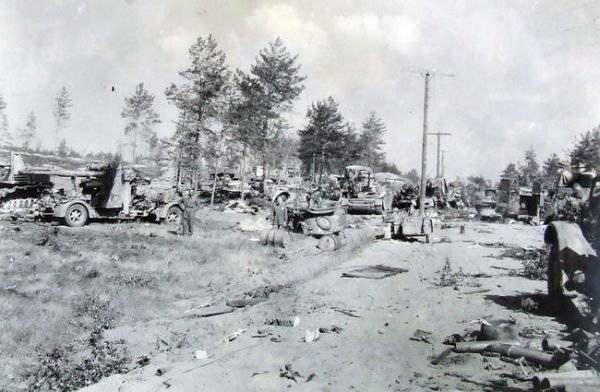
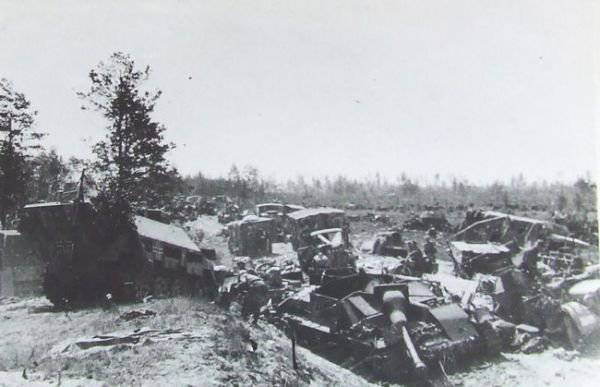
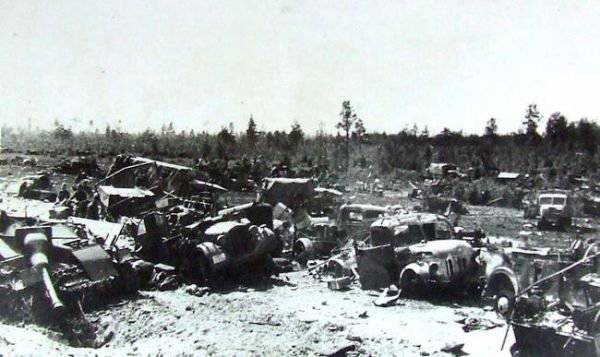
The poverty of the road network in Belarus and the marshy-wooded area led to the fact that many kilometers of German troops congregated on just two major highways - Zhlobin and Rogachev, where they were subjected to massive strikes by the Soviet 16 Air Force. Some German units were practically destroyed on the Zhlobin highway.

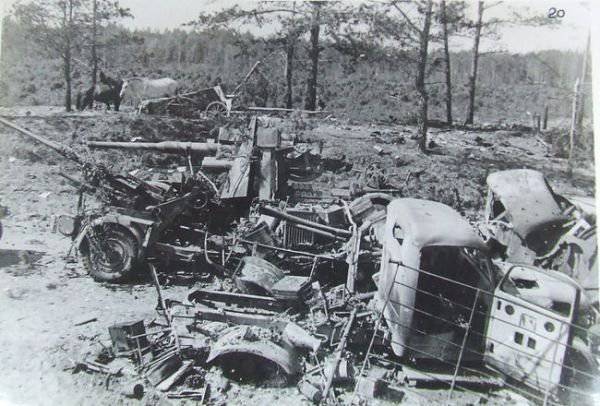
Photos of the destroyed German vehicles from the area of the bridge over the Berezina.
Second stage of the operation
The Germans tried to stabilize the situation. The head of the ground forces general staff, Kurt Zeitzler, proposed to transfer the Army Group North to the south, with the help of her troops to build a new front. But this plan was rejected by Hitler for political reasons (relations with the Finns). In addition, the naval command came out against it - leaving the Baltic States worsened communications with the same Finland and Sweden, and led to the loss of a number of naval bases and strongholds in the Baltic. As a result, Zeitzler resigned and was replaced by Heinz Guderian. The model, for its part, tried to erect a new defensive line, which ran from Vilnius through Lida and Baranavichy, in order to close a hole in the front about 400 km wide. But for this he had only one whole army - 2-I and the remnants of other armies. Therefore, the German command had to transfer considerable forces to Belarus from other sectors of the Soviet-German front and from the West. Before 16 July, 46 divisions were sent to Belarus, but these troops were not brought into battle immediately, in parts, often from the wheels, and therefore they could not quickly turn the tide.
From 5 to 20 in July 1944, the Vilnius operation was carried out by the forces of the 3 of the Byelorussian Front under the command of Ivan Danilovich Chernyakhovsky. The Germans did not have a solid front of defense on the Vilnius direction. On July 7, units of the Rotmistrov 5 Guards Tank Army and the 3 Guards Mechanized Corps Obukhov reached the city and began its girth. An attempt to immediately take the city failed. On the night of July 8, new German forces were pulled to Vilnius. 8-9 July the city was completely surrounded and it began its assault. Attempts by the Germans to unblock the city from the western direction were repulsed. The last pockets of resistance were suppressed in Vilnius on July 13. Up to 8 thousand Germans were destroyed, 5 thousand people captured. On July 15, parts of the front occupied several bridgeheads on the western bank of the Neman. Until 20-th number were fighting for bridgeheads.
On July 28, the troops of the 3 of the Belarusian Front launched a new offensive - they were aimed at Kaunas and Suwalki. July 30 was broken through the German defense on the Neman, on August 1 the Germans left Kaunas to avoid being surrounded. Then the Germans received reinforcements and went to the counteroffensive - the battles went with varying success until the end of August. The front did not reach several kilometers from the border of East Prussia.
The 1 Baltic Front of Baghramian was given the task of reaching the sea to cut off the North group. Initially, the Germans were able to restrain the offensive in the Dvinsk area, since the front was regrouping forces and waiting for reserves. Dvinsk was cleared in conjunction with the troops advancing to the right of the 2 of the Baltic Front only on July 27. On the same day they took Siauliai. By July 30, the front managed to separate two enemy army groups from each other — the advanced units of the Red Army cut the last railway between East Prussia and the Baltic states in the Tukums area. 31 July was captured by Jelgava. The 1 Baltic Front went out to sea. The Germans began to try to reconnect with Army Group North. The fighting went on with varying success, and at the end of August there was a break in the battles.
The 2-th Belarusian Front advanced westward toward Novogrudok, and then Grodno and Bialystok. Grishin's 49 Army and Boldin's 50 Army participated in the destruction of the Minsk "boiler", so on July 5 only one army went on the offensive - the 33. 33-I army attacked, not encountering much resistance, after passing for five days 120-125 km. 8 July Novogrudok was liberated, 9-th army reached the Neman River. On July 10, the 50 Army joined in the attack and the troops crossed the Neman. On July 16, Grodno was liberated, the Germans had already put up fierce resistance, a series of counterattacks were repulsed. The German command tried to stop the Soviet troops, but it did not have enough forces. July 27 was repulsed Bialystok. Soviet soldiers reached the pre-war border of the Soviet Union. The front was unable to conduct significant environments, since it did not have large mobile units (tank, mechanized, cavalry corps). August 14 was occupied by Osovets and the bridgehead beyond Narew.
The 1 Belorussian Front advanced in the direction of Baranavichy-Brest. Almost immediately, the advancing units encountered German reserves: the 4-I tank division, the 1-I Hungarian cavalry division, the 28-I light infantry division, and other formations. 5-6 July was a fierce battle. Gradually, the German forces were milled, they were inferior in number. In addition, the Soviet front was supported by powerful air force formations, which delivered strong blows to the Germans. 6 July was released Kovel. July 8 after a brutal battle were taken Baranavichy. 14 July took Pinsk, 20-th Kobrin. July 20 part of Rokossovsky on the move forced the Bug. The Germans did not have time to create a line of defense on it. On July 25 a “cauldron” was created near Brest, but 28-th remains of the surrounded German group broke out of it (the Germans lost 7 thousand people killed). It should be noted that the battles were distinguished by fierceness, there were few prisoners, but a lot of Germans killed.
On July 22, units of the 2 Tank Army (it was attached to the front during the second phase of the operation) reached the Lublin. On July 23, the city was stormed, but because of the lack of infantry, it dragged on, the city was finally taken on 25 in the morning. In late July - early August, the Rokossovsky front captured two large bridgeheads beyond the Vistula.
Operation results
- As a result of the two-month offensive of the Red Army, Belaya Rus was completely cleared of the Nazis, part of the Baltic states and eastern regions of Poland were liberated. In general, the advance of troops to a depth of 1100 km was achieved on the front in 600 kilometers.
- It was a major defeat for the Wehrmacht. There is even an opinion that this was the largest defeat of the German armed forces in World War II. Army Group Center was defeated, Army Group North was threatened. Broken a powerful line of defense in Belarus, protected by natural barriers (swamps, rivers). German reserves were exhausted, which had to be thrown into battle in order to close the "hole".
- An excellent groundwork has been created for the future offensive in Poland and further to Germany. Thus, the 1-th Belarusian Front seized two large bridgeheads beyond the Vistula south of the capital of Poland (Magnushevsky and Pulawski). In addition, in the course of the Lviv-Sandomierz operation, the 1 of the Ukrainian Front occupied a bridgehead at Sandomir.
- Operation "Bagration" was the triumph of Soviet military art. The Red Army "responded" for the "boilers" of 1941 of the year.
- The Soviet army lost up to 178,5 thousand dead, missing and captured, as well as 587,3 thousand thousand wounded and sick. The total loss of the Germans - about 400 thousand people (according to other sources more than 500 thousand).
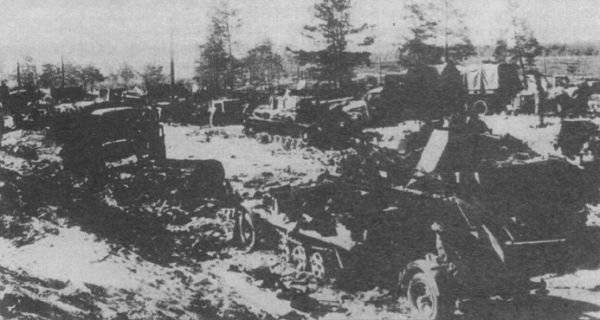
Rogachev highway.
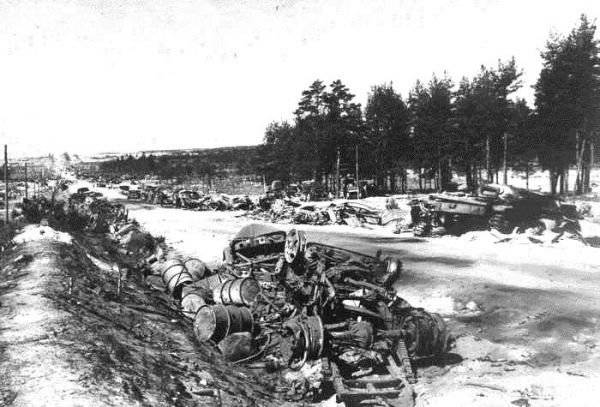
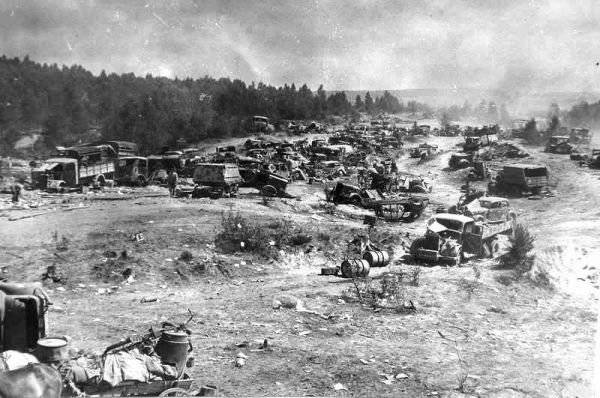
Highway near Vitebsk.
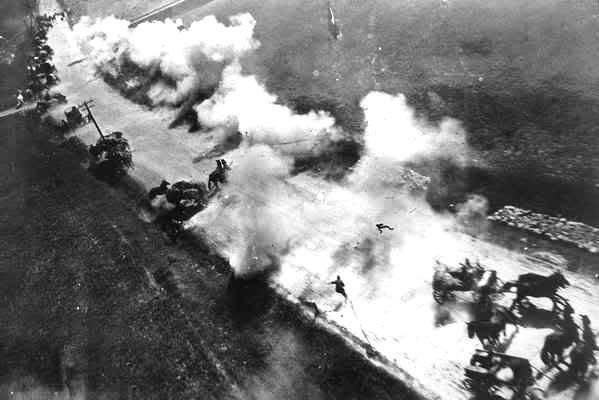
IL-2 attacks German column.
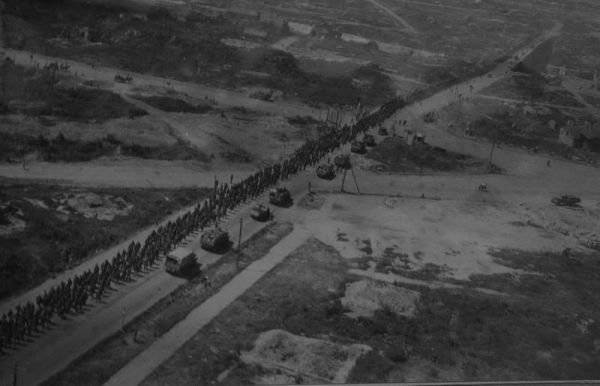
A column of German prisoners.
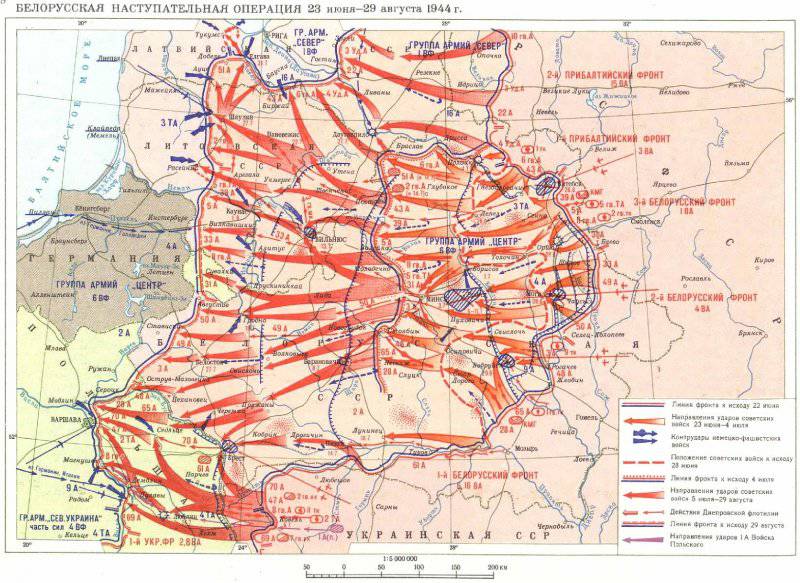
Information